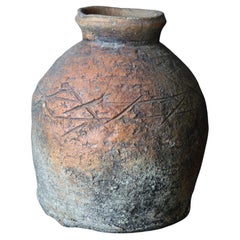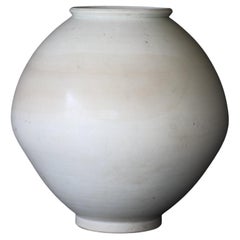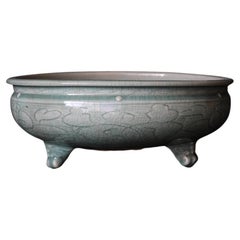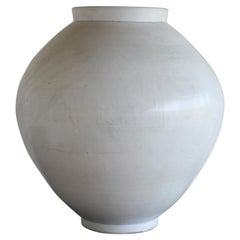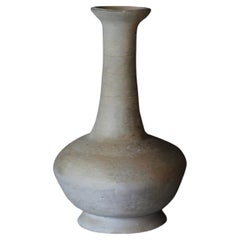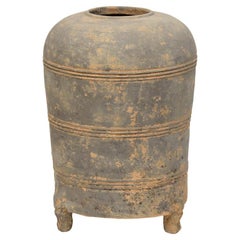&Antique Kyoto
to
21
12
5
4
Antique Shigaraki Jar "Uzukumaru"/Japanese Vase/14th-16th Century/Wabi-Sabi
Located in Kyoto-shi, Kyoto
During the Muromachi Period (1392–1573), the concept of wabi-sabi was formed from the tea ceremony culture.
Shigaraki ware was greatly influenced by the aesthetic sense of tea masters in the flow of the times.
This product is a small jar called "UZUKUMARU", which was used by farmers as a pot to store seeds.
The higaki pattern drawn on the body is unique to Shigaraki.
It is said that it is modeled after a shimenawa rope or the bamboo fence...
Category
Antique 15th Century and Earlier Japanese Antiquities
Materials
Ceramic
Moon Jar 'Dalhanari' - Lot2 / 17th Century / Korean Antiques / Joseon Dynasty
Located in Kyoto-shi, Kyoto
This is a white porcelain jar from the mid-Joseon period, also known as a "Talhunari" or "moon jar". During the Joseon Dynasty, which was strongly influenced by Confucianism, the purity of white porcelain was particularly prized in its artistic expression due to its Confucian sensitivity. The defining characteristic of white porcelain during this period was its pure white color, but there were many subtle variations in the white hues, with some being classified as milky white, snowy white, ashen white, and bluish white.
The term "Talhunari" means "moon jar" in Korean, and it refers to the large, round shape of the jar, resembling a full moon. It was named by Kim Whanki, a representative abstract painter of Korea. The soft, curving lines and sturdy body that seems to embrace the full moon give the jar both power and tranquility. This type of jar was produced in large quantities during the 17th century.
The white of the moon jar is not the pure white of early Joseon porcelain...
Category
Antique 17th Century Korean Antiquities
Materials
Ceramic, Porcelain
Moon Jar 'Dalhanari', Lot3 / 17th Century / Korean Antiques / Joseon Dynasty
Located in Kyoto-shi, Kyoto
This is a white porcelain jar from the mid-Joseon period, also known as a "Talhunari" or "moon jar". During the Joseon Dynasty, which was strongly influenced by Confucianism, the purity of white porcelain was particularly prized in its artistic expression due to its Confucian sensitivity. The defining characteristic of white porcelain during this period was its pure white color, but there were many subtle variations in the white hues, with some being classified as milky white, snowy white, ashen white, and bluish white.
The term "Talhunari" means "moon jar" in Korean, and it refers to the large, round shape of the jar, resembling a full moon. It was named by Kim Whanki, a representative abstract painter of Korea. The soft, curving lines and sturdy body that seems to embrace the full moon give the jar both power and tranquility. This type of jar was produced in large quantities during the 17th century.
The white of the moon jar is not the pure white of early Joseon porcelain...
Category
Antique 17th Century Korean Ceramics
Materials
Ceramic, Porcelain
Celadon Incense Burner with Peony Arabesque Design/Chinese Antique/14th-17th C
Located in Kyoto-shi, Kyoto
This is a Celadon three-legged incense burner with peony arabesque design.
Since the 14th century, Dwarf sedge was planted in this pot to decorate the tea room, so in Japan it is ...
Category
Antique 15th Century and Earlier Antiquities
Materials
Ceramic
White Porcelain Moon Jar, Joseon Dynasty / 1392-1897
Located in Kyoto-shi, Kyoto
This is a white porcelain jar from the mid-Joseon period, also known as a "Talhunari" or "moon jar". During the Joseon Dynasty, which was strongly influenced by Confucianism, the purity of white porcelain was particularly prized in its artistic expression due to its Confucian sensitivity. The defining characteristic of white porcelain during this period was its pure white color, but there were many subtle variations in the white hues, with some being classified as milky white, snowy white, ashen white, and bluish white.
The term "Talhunari" means "moon jar" in Korean, and it refers to the large, round shape of the jar, resembling a full moon. It was named by Kim Whanki, a representative abstract painter of Korea. The soft, curving lines and sturdy body that seems to embrace the full moon give the jar both power and tranquility. This type of jar was produced in large quantities during the 17th century.
The white of the moon jar is not the pure white of early Joseon porcelain...
Category
Antique 18th Century Korean Ceramics
Materials
Ceramic, Porcelain
Sue Ware Long Neck Jar / Japanese Antique / Asuka Period / 592-710 CE
Located in Kyoto-shi, Kyoto
Among Japanese Sue ware, the long-necked jar is a relatively new vessel that appeared around the 7th century. A typical long-necked jar with a delicately shaped bottom and a small body. Medieval...
Category
Antique 15th Century and Earlier Japanese Antiquities
Materials
Ceramic
Moon Jar / Korean Antique vase / Joseon Dynasty / 18th Century
Located in Kyoto-shi, Kyoto
It's a wonderful moon jar. It is a rare size that is suitable for the alcove of a Japanese tea room. It is shaped at once without connecting the uppe...
Category
Antique 18th Century Korean Antiquities
Materials
Ceramic
Sue Ware /Antique Japanese vase/4th-8th century/Wabi-sabi
Located in Kyoto-shi, Kyoto
This cup is an example of the type of stoneware known as Sue ware, produced from the middle of the fifth until the fourteenth century in Japan.
This produc...
Category
Antique 15th Century and Earlier Japanese Antiquities
Materials
Pottery
Vermillion Lacquer Rinka Tray/Chinese Antique/14th-17th century/Tea ware
Located in Kyoto-shi, Kyoto
This product is a rare six-sided vermillion lacquer rinka (ring of flowers) tray. It was made in the late Yuan and early Ming dynasties. It has been ca...
Category
Antique 15th Century and Earlier Chinese Antiquities
Materials
Wood
Johoji Lacquerware Katakuchi Choshi/Japanese Antique/Wabi-Sabi/1336-1573CE
Located in Kyoto-shi, Kyoto
Muromachi period old Joboji lacquered Kataguchi Choshi. There are very few extant items from this era, and they are very rare items.
This item has weathered over time, and the coa...
Category
Antique 15th Century and Earlier Antiquities
Materials
Wood
Longquan Celadon Plate / Chinese Antique / Song to Yuan Dynasty / 13th Century
Located in Kyoto-shi, Kyoto
The Longquan kiln, situated in Longquan City of China's Zhejiang Province, thrived in the Song and Yuan eras. It is characterized by its beautiful green celadon ware, created by appl...
Category
Antique 15th Century and Earlier Chinese Ceramics
Materials
Ceramic, Celadon
Kundika Bottle Celadon with Incised Flower / 12th Century / Korean Antique
Located in Kyoto-shi, Kyoto
A "Johin" is a vase used to hold pure and clean water. According to the ancient Buddhist scripture "Lotus Sutra," it was originally one of the 18 tools that Buddhist monks were required to possess, but later came to be used as a vessel for offering clean water to the Buddha. During Korea's Goryeo period, it was also commonly used as a water storage container.
The vase is adorned with delicate floral patterns engraved with fine lines on its front and back. Among other Goryeo celadon...
Category
Antique 15th Century and Earlier Korean Ceramics
Materials
Ceramic, Celadon
Bottle Buncheong Ware / 15th Century / Korean Antiques / Joseon Dynasty
Located in Kyoto-shi, Kyoto
Powder blue celadon ware is a type of porcelain made in Korea during the first half of the Joseon dynasty, mainly in the 15th century. It was made by applying a fine white slip over iron-rich clay, then covering it with a transparent glaze and firing it. It was mainly used for daily utensils such as bowls and bottles.
Joseon ceramics...
Category
Antique 15th Century and Earlier Korean Antiquities
Materials
Ceramic, Porcelain
Jun Ware Vase with Red Glaze and Dragon Ears / Chinese Antiques / Qing Dynasty
Located in Kyoto-shi, Kyoto
Jun ware's red glaze is made with copper red glaze and applied to the surface of porcelain before firing. Due to the high temperature at which the glaze is fired, copper oxide precip...
Category
Antique 18th Century Chinese Antiquities
Materials
Ceramic, Porcelain
White Porcelain Incense Burner / Korean Antique / Joseon Dynasty/1392 - 1897 CE
Located in Kyoto-shi, Kyoto
This incense burner presents the characteristics of a typical Yi Dynasty Joseon Dynasty incense burner with a body that rises smoothly from the base, openworked ears and a semi-circu...
Category
Antique 17th Century Korean Antiquities
Materials
Ceramic
Maki-E Four-Sided Tea Shelf / Japanese Antique / 18th Century
Located in Kyoto-shi, Kyoto
An old tea shelf from around the 18th century with maki-e painted on all four sides. The lacquer work of this product is a delicate artwork, and the composit...
Category
Antique 18th Century Japanese Antiquities
Materials
Wood
White Porcelain Vase / 17th Century / Korean Antiques / Joseon Dynasty
Located in Kyoto-shi, Kyoto
This product is a white porcelain bottle from the Joseon Dynasty. People in those days used bottles like this to make soap from waste oil.
With use, the porcelain frayed and curle...
Category
Antique 17th Century Antiquities
Materials
Ceramic, Porcelain
Tokoname Sutra Jar, Heian-Kamakura/Japanese Antique/8th-14th Century
Located in Kyoto-shi, Kyoto
This is an old Tokoname sutra jar from the Heian to Kamakura periods. It has a shape that traces the lineage of medium-sized Sue ware pots, and is a unique ty...
Category
Antique 15th Century and Earlier Antiquities
Materials
Ceramic, Pottery
Antique Ironware, Incense Plate, Indonesia 18th Century
Located in Kyoto-shi, Kyoto
Old ironware from the 18th century.
It is an old ironware used in Balinese ceremonies. This item is in the shape of a water buffalo horn and is extremely rare.
There is no unnecessary decoration, there is a simple sophisticated atmosphere, it is an art piece.
As in the first photo, it is also recommended to enjoy it likened to an incense plate.
Category
Antique 18th Century Balinese Antiquities
Materials
Iron
Jomon Pottery Deep Bowl /Antique Japanese vase/c. 14, 000–300 BC/Wabi-sabi
Located in Kyoto-shi, Kyoto
It is a deep bowl-shaped Jomon pottery with a flat bottom, a cylindrical body, and a slightly open rim. The rim is pasted with decorations made of thin c...
Category
Antique 15th Century and Earlier Antiquities
Materials
Earthenware, Pottery
Yayoi Earthenware Deep Bowl/Antique Japanese vase/300 BCE – 250 CE/Wabi-sabi
Located in Kyoto-shi, Kyoto
A large pot from the early Yayoi period.
The Yayoi period is one of the oldest historical periods of Japan spanning from c. 300 BCE to c. 250 CE
It is a ...
Category
Antique 15th Century and Earlier Antiquities
Materials
Earthenware
Related Items
Han Dynasty, Antique Chinese Pottery Granary Jar
Located in Sampantawong, TH
Chinese pottery granary jar, with cylindrical shape, decorated with bands of incised lines, and supported by three legs.
Age: China, Han Dynasty, 206 B.C. - A.D. 220
Size: heigh...
Category
Antique 15th Century and Earlier Chinese Antiquities
Materials
Pottery
14th - 16th Century, Sukhothai, Antique Thai Sukhothai Ceramic Covered Bowl
Located in Sampantawong, TH
Antique Sukhothai ceramic covered bowl.
Age: Thailand, Sukhothai Period, 14th - 16th Century
Size: Height 10 C.M. / Width 12 C.M.
Condition: Nice glaze and condition overall, a tiny...
Category
Antique 15th Century and Earlier Thai Antiquities
Materials
Ceramic
Han Dynasty, Antique Chinese Green Glazed Pottery Jar
Located in Sampantawong, TH
Chinese green glazed pottery jar.
Lead glaze with copper is the main colorant used in Han period to produce green glaze. Greenware became popular during the Eastern Han...
Category
Antique 15th Century and Earlier Chinese Antiquities
Materials
Pottery
Japanese Antique Muromachi Edo Wabi-Sabi Tokoname Art Pottery Jar Tsubo Pot Vase
Located in Studio City, CA
An absolutely stunning Tokoname ware stoneware vase/jar/vessel - produced sometime during the late Muromachi period (1336-1573 to early Edo Period (1603-1867). Tokoname-yaki ware is ...
Category
Antique 16th Century Japanese Edo Ceramics
Materials
Pottery, Stoneware
H 13 in W 10 in D 10 in
Korean White Glazed Jar, Joseon Dynasty, 18th Century, Korea
Located in Austin, TX
A sublime Korean white glazed porcelain globular jar, Joseon Dynasty, 18th century, Korea.
The squat jar is heavily potted, with a globular body, very short neck, and wide mouth r...
Category
Antique 18th Century Korean Ceramics
Materials
Porcelain
Japanese Antique Momoyama Edo Bizen Ware Pottery Wabi-Sabi Art Tsubo Jar Vase
Located in Studio City, CA
An absolutely stunning Bizen ware stoneware vase/jar/vessel - produced sometime during the late Momoyama period (1568-1600) / Early Edo Period (1603-1867). Bizen yaki...
Category
Antique 16th Century Japanese Edo Ceramics
Materials
Stoneware
H 10.25 in W 8.5 in D 8.5 in
Yuan Dynasty, Antique Chinese Brown Glazed Pottery Jar
Located in Sampantawong, TH
Chinese brown glazed pottery jar with round shape.
Age: China, Yuan Dynasty, 13th Century
Size: height 21.8 cm / width 27.5 cm
Condition: Well-preser...
Category
Antique 15th Century and Earlier Chinese Antiquities
Materials
Pottery
Japanese antique pottery lion-shaped incense burner / 17th - 18th century / Edo
Located in Sammu-shi, Chiba
This is a Japanese "Seto" fired pottery incense burner.
Seto is a kiln with a long history in Aichi Prefecture, Japan. (Seto kilns are marked with red circles on the map.)
It is said...
Category
Antique 17th Century Japanese Edo Antiquities
Materials
Pottery
H 6.89 in Dm 5.52 in
Japanese Antique Paper-Covered Pottery Jar 1800s-1860s / Flower Vase Wabi Sabi
Located in Sammu-shi, Chiba
This is a very old Japanese paper-lined ceramic jar.
It is from the Edo period (1800s-1860s).
We assume that this jar was used to extinguish charcoal fires.
It is covered with paper...
Category
Antique Late 19th Century Japanese Edo Ceramics
Materials
Pottery
H 10.04 in W 10.24 in D 9.06 in
Pair of Antique Chinese Han Dynasty Green Glazed Pottery Granary Jars
Located in Sampantawong, TH
A pair of Chinese green glazed pottery granary jars with bear-shaped legs.
Age: China, Han Dynasty, 206 B.C. - A.D. 220
Size: Height 27.7 - 28.2 C.M. / Width 18.7 - 19.5 C.M.
Co...
Category
Antique 15th Century and Earlier Chinese Antiquities
Materials
Pottery
Korean White Glazed Porcelain Bottle Vase, Joseon Dynasty, 18th Century
Located in Austin, TX
A quiet and elegant Korean white glazed bottle vase, Joseon Dynasty, late 18th century, Korea.
The graceful vase beautifully proportioned, resting on a short recessed foot, with a...
Category
Antique Late 18th Century Korean Ceramics
Materials
Porcelain
Han Dynasty, Antique Chinese Green Glazed Pottery Jar
Located in Sampantawong, TH
Chinese green glazed pottery jar in globular form with plain decoration.
Lead glaze with copper is the main colorant used in Han period ...
Category
Antique 15th Century and Earlier Chinese Antiquities
Materials
Pottery
